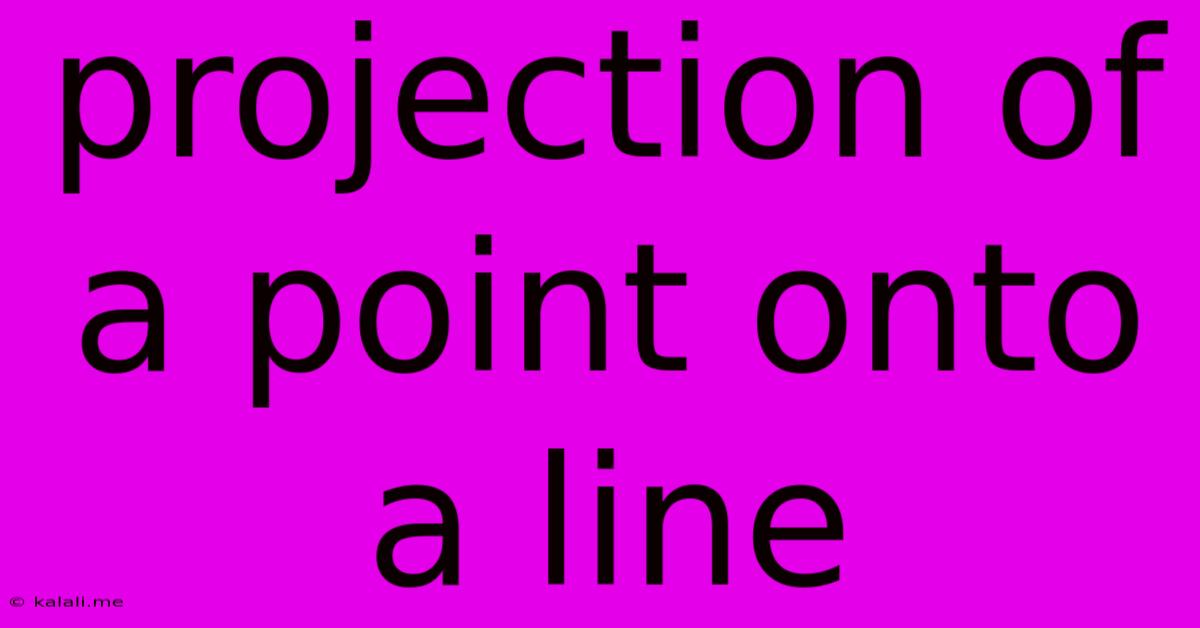Projection Of A Point Onto A Line
Kalali
May 25, 2025 · 3 min read

Table of Contents
Projecting a Point onto a Line: A Comprehensive Guide
This article provides a comprehensive guide to understanding and calculating the projection of a point onto a line. We'll cover the underlying concepts, different approaches to solving the problem, and practical applications. This is crucial in various fields like computer graphics, linear algebra, and physics. Learn how to accurately find the closest point on a line to a given point in space.
Understanding the Concept
The projection of a point onto a line is essentially finding the point on the line that is closest to the given point. Imagine shining a light directly down from the point onto the line; the point where the light hits the line is the projection. This shortest distance is always perpendicular to the line. This perpendicularity is key to solving the problem.
Methods for Calculating the Projection
There are several methods to calculate this projection, each with its own strengths and weaknesses. We'll explore two common approaches: using vector projection and using the distance formula.
1. Vector Projection Method
This method leverages the power of vector algebra. Let's define:
- P: The point we want to project (represented as a vector).
- A: A point on the line.
- v: The direction vector of the line.
The projection of P onto the line is given by the formula:
proj<sub>v</sub>P = ((P - A) • v) / ||v||² * v
Where:
- (P - A) • v represents the dot product of (P - A) and v.
- ||v||² represents the squared magnitude of vector v.
This formula essentially scales the direction vector v by the scalar component of (P-A) along v. This scaled vector, when added to point A, gives the projected point.
Example: Let's say P = (2, 3), A = (1, 1), and the line has direction vector v = (1, 0). Plugging these values into the formula will provide the coordinates of the projected point.
2. Using the Distance Formula and Perpendicularity
This approach uses the distance formula and the property that the line connecting the point and its projection is perpendicular to the line. This often involves solving a system of equations, particularly when dealing with lines represented in standard form (Ax + By + C = 0).
This method is generally more intuitive to visualize but can be more computationally intensive, especially for lines not aligned with the coordinate axes. It involves finding the equation of the line perpendicular to the given line that passes through the given point, and then finding the intersection of this perpendicular line and the original line. This intersection point is the projection.
Applications of Point Projection
The projection of a point onto a line has numerous applications across various disciplines, including:
- Computer Graphics: Used extensively in 3D rendering to determine shadow casting and other visual effects. Think of projecting a point light source onto the surface of an object.
- Machine Learning: Used in dimensionality reduction techniques and closest-point algorithms.
- Physics: In mechanics, calculating the component of a force acting along a particular direction.
- Robotics: Calculating the closest point on a path or trajectory.
Conclusion
Understanding how to project a point onto a line is a fundamental concept with wide-ranging applications. Both the vector projection method and the distance formula method offer viable solutions depending on the context and the representation of the line. Mastering these techniques provides valuable tools for various computational and analytical tasks. Remember to choose the method best suited to your specific problem and available data.
Latest Posts
Latest Posts
-
What Is 1 4 Of 1 4 Cup
Jul 02, 2025
-
Is Keri Russell Related To Kurt Russell
Jul 02, 2025
-
What Is Half Of 1 4 Teaspoon
Jul 02, 2025
-
How Many Cups In A Pound Of Hamburger Meat
Jul 02, 2025
-
Imagery Or Figurative Language From Romeo And Juliet
Jul 02, 2025
Related Post
Thank you for visiting our website which covers about Projection Of A Point Onto A Line . We hope the information provided has been useful to you. Feel free to contact us if you have any questions or need further assistance. See you next time and don't miss to bookmark.